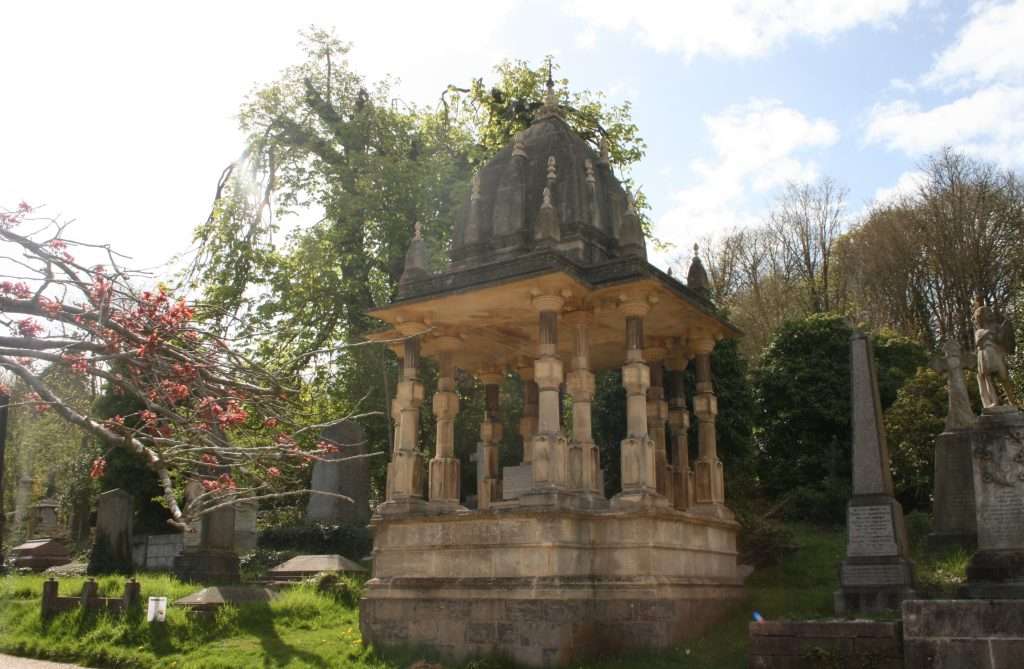At Arnos Vale Cemetery in Bristol a magnificent chattri towers incongrously above the angels, crosses, and obelisks which line the Ceremonial Way. Made from Bath stone but based on a traditional Bengali funeral monument, and much the grandest of the Victorian memorial sculptures, it marks the grave of Raja Ram Mohan Roy.


Raja Ram Mohan Roy, often referred to as The Father of Modern India, was a linguist and philosopher, committed to female rights, education, and religious reform. He was born into the Kulin Brahmin, those Bengali Brahmins designated Kulina or superior. They advocated the prevailing systems of polygamy, dowry, sati, caste rigidity and child marriage. In his childhood he witnessed the burning to death of his seventeen-year-old sister-in-law in a sati ceremony. Mohan Roy championed a social reform Hinduism which opposed all these practices, leading to conflict with the authorities of the day and with his own family. Committed to monotheism, he co-founded the Kolkata Unitarian Society in 1822 and the Brahmo Samaj in 1828, the latter specifically seeking to reform Kulin Brahminism tempering it with Unitarian beliefs.
For Mohan Roy, education was the key to social reform, and he established schools where teachers incorporated western learning into Indian education, believing that modern subjects were vital to prepare young people for success in the world. This integration of eastern and western culture brought further criticism, as did his emphasis on the particular importance of education for girls.
He travelled widely, learning many languages, and defying the Hindu prohibition on crossing the Kala Pani, the Black Water, or the seas which separate India from foreign lands. Such journeys resulted not only in loss of social respectability but also, it was believed, precluded reincarnation when individuals were cut off from the regenerating waters of the Ganges.
Roy had been instrumental in obtaining a ban on the practice of sati which the British East Indian Company had long condoned to facilitate their own trading and colonial expansion. In 1830 he came to Britain, acting as Ambassador for the Mughal emperor, and successfully pressured the British government into upholding the ban.
While in Britain the Raja visited his Unitarian friends in Bristol including Lant Carpenter and his daughter Mary. Influenced by her contact with him, Mary was to become a political and social activist campaigning against slavery, for prison reform, female education, and latterly for female suffrage.
Sadly, the Raja was never to leave Bristol, for in 1833 he died of meningitis while staying at Beech House, the home of Unitarian friends in the suburb of Stapleton. According to Hindu beliefs he should have been cremated but in the England of 1833 this was still illegal. Non-Christian burials in Christian graveyards were also prohibited. And so, at a silent service, his friends buried him in the grounds of Beech House.
Ten years later new owners had purchased Beech House. Consequently, William Carr and William Prinsep, businesspeople who had worked in Kolkata, bought a plot in the new cemetery which the Bristol General Cemetery Company had established at Arnos Vale . They moved Mohan Roy’s coffin to a brick lined vault in an unconsecrated section of the cemetery. The chattri was designed by Prinsep and funded by Dwarkanath Tagore.
There is a celebration of the life of Raja Ram Mohan Roy every year at Arnos Vale on the Sunday closest to the anniversary of his death on 27th September 1833. This year marked the 250th anniversary of his birth in 1772. Anyone is welcome at the ceremony and so I joined members of Brahmo Samaj, Unitarians, a representative of the Indian High Commission, The Lord Mayor of Bristol, staff and volunteers at Arnos Vale, and other members of the public to honour the life and achievements of this remarkable man.





There are other tributes to Mohan Roy in Bristol:
In Bristol Art Gallery, a magnificent portrait of the Raja provides a burst of colourful magnificence dominating a room of Victorian art.


In 1998 the Indian government presented a bronze statue of Raja Ram Mohan Roy to the City of Bristol in celebration of fifty years of Indian Independence. It stands outside the cathedral on College Green.

There is a plaque on the wall of Beech House in Stapleton.


Next year the ceremony at Arnos Vale will be on 24th September.
https://arnosvale.org.uk/remembering-the-raja
Arnos Vale Cemetery closed and fell into neglect in the 1980s. With no room for new burials, the income of the private for-profit company which owned it disappeared. With fewer descendants left to care for graves the cemetery become overgrown and vandalised. In 1987 the company proposed to clear away the graves and use the land for commercial development. The Friends of Arnos Vale Cemetery led a successful campaign to save it, and in 2003 Bristol City Council made a compulsory purchase order. Today volunteers have cleared away brambles and overgrown paths, restored monuments, and cleaned graves. They host tours, talks, film, theatrical and musical productions. And they have a great café where in fine weather you can sit outside with the forty-five green acres of the new Eden stretching before you. If you find yourself in Bristol pay them a visit.
